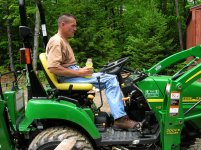You are using an out of date browser. It may not display this or other websites correctly.
You should upgrade or use an alternative browser.
You should upgrade or use an alternative browser.
Grading How does my three point float work GC1705?
- Thread starter atsah
- Start date
- Views: 45278
More options
Who Replied?
/ How does my three point float work GC1705?
#61
Very nice setup on the hand control, Kootch88 did something similar quite some time ago.
Thanks.. I did one in 08 on my 2305 and it came out really nice, I was able to bring the linkage straight up and over the dash with the pillar block bearings mounted on the metal between the hood and dash, this Massey is better for me in other ways but I did like the setup on the Deere a little better, it would have given me a little more leg room but It's not an issue..
Don't mind me, I'm just thirsty..
Attachments
TripleR
Super Star Member
- Joined
- Mar 5, 2009
- Messages
- 18,538
- Location
- Missouri
- Tractor
- Kubota M8540HDC, L5740HSTC, BX2200, BX2660, John Deere 425&1025R, Case, Massey Ferguson, Ford
Nice setup on the 2305, we had one until a fuel tank fell on it and we replaced it with the 1025R, much better machine. I have issues with an old spinal cord injury and use a stick and rope for engaging 4WD as my fabrication skills are on a par with my understanding of quantum physics.:laughing:
I'll get my brother to fab something up one of these days if I lose my stick.
I'll get my brother to fab something up one of these days if I lose my stick.
LOL.. If anyone ever needs any modification help I would be more than happy to help with parts and ideas.. There is no reason a guy with the drive to operate a tractor after injury's shouldn't do so.. IMO there is no better feeling than getting on my tractor and doing a little work with it, my little 1705 has become my right hand..
Here are some similar links:
- Replies
- 29
- Views
- 6K
